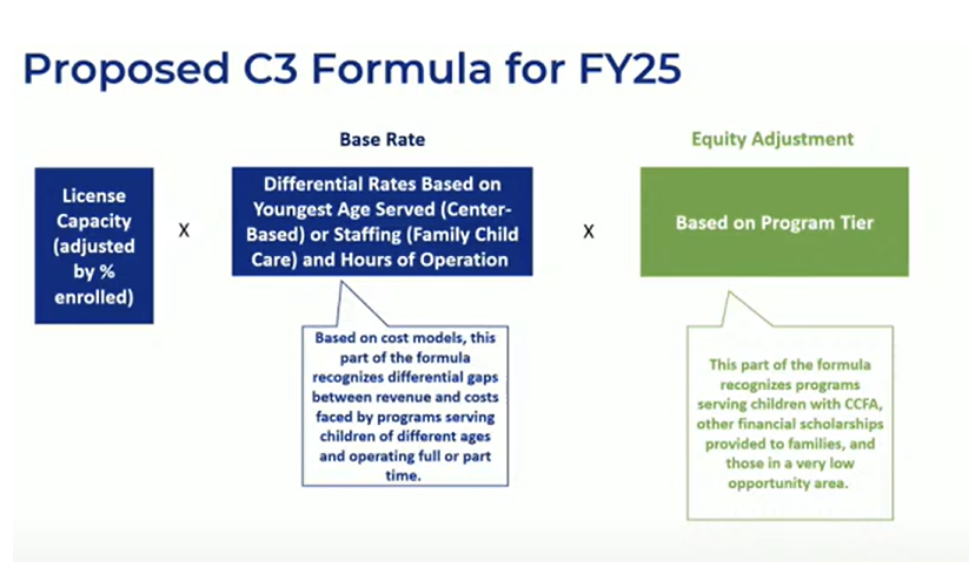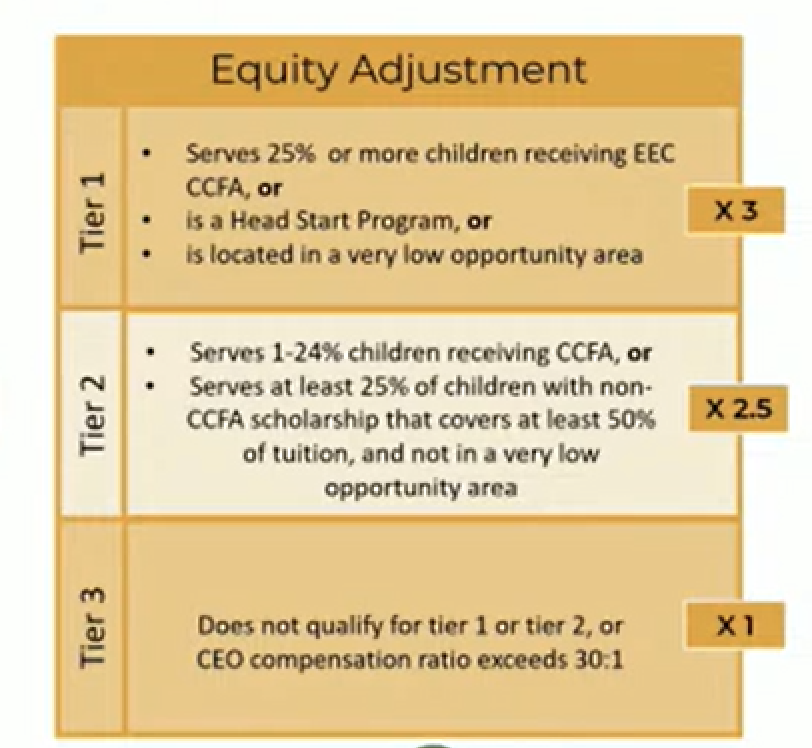RECAP of the September EEC Board Meeting: Looking Back at FY24 and ahead to FY25
At Neighborhood Villages, we prioritize keeping up with the policy landscape in the early education and care field, both across the country and in Massachusetts. That includes tuning-in to the monthly meetings of the Massachusetts Board of Early Education and Care (“EEC Board”), to stay apprised of updates and to identify opportunities for how we can work with government and other stakeholders to improve our early education and care system.
This month’s meeting – on September 11, 2024 – marked the first meeting of the 2025 fiscal year (FY25), which goes from July 1, 2024 to June 30, 2025. The primary topics of this month’s Department of Early Education and Care (EEC) Board meeting were: (1) FY25 budget updates, (2) review and status of the Child Care Financial Assistance (CCFA) contracted provider request for responses (RFR), and (3) program updates on Commonwealth Cares for Children (C3). Here’s what you need to know…
If You Are a Provider:
EEC shared its revised plan for the Commonwealth Cares for Children (C3) grants program for fiscal year 2025. EEC presented the revised C3 funding formula, noting that in developing the formula for FY25, it also accounted for additional requirements included in budgetary outside sections that make C3 permanent beginning July 2025. The budget requires a distribution of funds according to certain program characteristics. The funding formula accounts for these characteristics through the equity adjustment portion of the formula. EEC indicated that its goals for the C3 program remain the same as those previously shared, but that due to legislative changes that occurred over the summer, updates are being made for FY25.
Further, EEC looked at recommended staffing and salaries built into cost modeling to understand how costs varied for different program types. The new formula’s base rates integrate staffing expected by the models for programs that vary by ages of children served and hours of operation. As such, the base rates are now distinct for full- versus part-time programs. For centers, the base rate accounts for the age of the youngest child enrolled (the biggest cost driver), while for FCCs, the base rate accounts for the presence and hours of an assistant (the biggest cost driver). The graphics from the Board meeting show the full formula’s components and the detail of the equity adjustment.
LICENSE CAPACITY (Adjusted by % Enrolled)
License capacity is the number of children a program is licensed to serve. In order to account for programs with enrollment that diverges significantly from capacity, EEC will look at a program’s last 12 months of enrollment.
For center programs with average enrollment over the past 12 months that is greater than 75%, they will receive grant amount based on full capacity; if a program’s enrollment average is less than 75%, the grant amount will be prorated (i.e., proportionately adjusted downward).
For FCCs, EEC will continue to use a base capacity of 10 for all FCCs and those that have enrolled at least 3 children (average) over the last 12 months will receive the full grant amount, while FCCs with less than 3 children (average) will have grant amounts adjusted downward accordingly.
BASE RATE
The base rate is the per-child dollar-amount a program will receive based on its capacity (as adjusted for enrollment, if applicable – see above). EEC has established standardized base rates for center programs and FCCs, differentiated for full- and part-time programs and differentiated further within centers by age of children served and within FCCs by assistant status. For centers, the rate is the same for every child, although it is based on the age of the youngest child served (e.g., if a center serves infants and toddlers, they will receive the infant rate for all children, including toddlers).
EQUITY ADJUSTMENT
After having established a program’s capacity with any adjustment for enrollment,
multiplied by a base rate depending on the program type, EEC will then multiply
that amount by either 3, 2.5, or 1, which corresponds to the program or provider’s assignment to either Tier 1, Tier 2, or Tier 3, respectively. Program characteristics that define tiers are below, with Tier 1 representing programs with the greatest indicators of serving children with highest need, Tier 2 representing programs with some indicators of serving children with high needs, and Tier 3 representing programs that do not fall into Tier 1 or Tier 2 and/or have a CEO who is compensated greater than 30 times the lowest paid educator. For calculation of the percent of CCFA, EEC will use a program’s highest percentage of children with CCFA over the last year.
For more information, keep an eye out for our upcoming fact sheet regarding the new formula, visit mass.gov/c3 or sign up for one of the informational sessions regarding the C3 program changes that EEC will hold.
2. Among the initiatives planned for FY25, EEC plans the following, within each of its strategic areas:
Family Access: Develop a strategy to better support Family, Friend & Neighbor Care
Program Stability: Develop and implement FY25 rate increase
Program Quality: Execute a continuous quality improvement (CQI) pilot
Workforce Support: Launch an educator credential as well as new apprenticeship and “pipeline” programs
3. EEC provided an update on the highlights of the FY25 budget, including each of the line items for early education and care, as well as the outside sections. For more information on the budget, see Neighborhood Villages’ Budget Debrief. Among those items in the outside sections of the budget (the statutory changes to general law, outside of budgetary appropriation line items), EEC highlighted the removal of the statutory cap on the number of children that can be served by Family Child Care programs (currently 10). EEC explained that this change allows for a review of FCC group size and ratios – essentially, it gives EEC flexibility to take up regulatory changes to group size and ratios, but this change does not make any immediate changes to current FCC capacity limits.
4. EEC provided an overview and status update regarding the recent procurement of new contracts with providers serving low-income and special populations through the Child Care Financial Assistance (CCFA) program through contracted slots. CCFA is administered by EEC through three programs – Department of Children and Families-related, Department of Transitional Assistance-related, and Income-Eligible – and does so in the form of either vouchers or contracted slots. Vouchers can be used by families at any program that accepts CCFA and are administered by Child Care Resource and Referral agencies (sub-contractors of EEC). In contrast, contracted slots are program-specific, so an award for a contracted slot can only be used at the program that holds the contract for that slot. Family eligibility rules are the same for contracts and vouchers and they are paid at the same EEC daily reimbursement rate.
For the first time since 2009, new contracts are being awarded. In all, approximately 110 providers will receive contracts that provide seats reserved with children eligible for Child Care Financial Assistance. Of the 196 bids made for contracts, 184 were successful. Bids are based on the population to be served and, as such, providers could submit multiple bids to cover different populations, e.g., income-eligible and families experiencing homelessness. The new contract awards will be executed starting on October 1, 2024 and will last for three years, however EEC has the option to re-open bids annually. The new contracts have built-in quality expectations, as well as commitment from EEC to provide Technical Assistance to providers. These items include: incorporating clearly defined customer service and communication expectations, instituting consistent staffing expectations for programs and umbrella agency staff, outlining training and professional development criteria for programs and staff, and introducing Key Performance Indicators (KPIs). Finally, a notable change to the contracts is making transportation services a separate critical supportive service for priority population contracts by creating a daily per-child transportation rate for all priority population families and reimbursing providers for each child receiving transportation through the contract.
If You are a Parent/Guardian or Child Care Advocate:
The EEC Board welcomed two new members: Dr. Kim Lucas of Northeastern University and Jennifer James Price of North Shore Community College (and formerly Undersecretary of Workforce Development for the Massachusetts Executive Office of Labor and Workforce Development). Dr. Lucas serves as an expert in the evaluation and assessment of successful pre-school education programs. Ms. Price serves as a member at-large.
Secretary Tutwiler shared an update on the Governor’s Early Education and Child Care Task Force, noting that the Task Force hosted 14 sessions across the state over the summer. He further shared that the next steps for the Task Force are to 1) organize the feedback they received with research on promising practices; and 2) present a set of recommendations based on what they’ve learned.
Secretary Tutwiler noted that the week of Oct 21st is STEM week, and this year the focus will be on early learners. Stay tuned for further details on events that will center activities in early education spaces.
Michelle Haimowitz, Executive Director of the Massachusetts Head Start Association, gave public comment regarding the recent Head Start federal Final Rule and its potential impact on MA. Ms. Haimowitz noted that 30% of Head Start children in MA also receive a child care subsidy to supplement and provide full-day, full-year care. She shared that the Head Start Program Performance Standards – the subject of the Final Rule – govern all aspects of Head Start program operations and that the many changes come without any additional funding for implementation. Among the changes, the rule requires that – by 2031 – programs must pay teachers comparably to those in K-12. All of the changes will have a ripple effect on the broader early education and child care sector.
Among EEC’s accomplishments in FY24, Commissioner Kershaw highlighted the the following: Securing $3.3M in capital funding for CCFA technology modernization for FY25, as part of the FutureTech Act, defining key performance indicators for each of EEC’s five strategic objectives and completing backend development to enable the creation of live KPI dashboards, launching EEC’s first ever Diversity, Equity, Inclusion, and Belonging Council, and filling more than 40 positions across the department, including the first-ever Family Engagement Manager and Priority Access Manager, among others.
If You Are an Educator:
EEC’s Early Childhood Educators Scholarship for pursuing higher education degrees is still open. EEC has held informational sessions about this opportunity, which has been expanded to make additional staff eligible (including residential workers) and additional majors acceptable for enrolled students, and has simplified the eligibility verification process. There is one additional listening session regarding this opportunity, to be held on September 25th. Sign up here.



